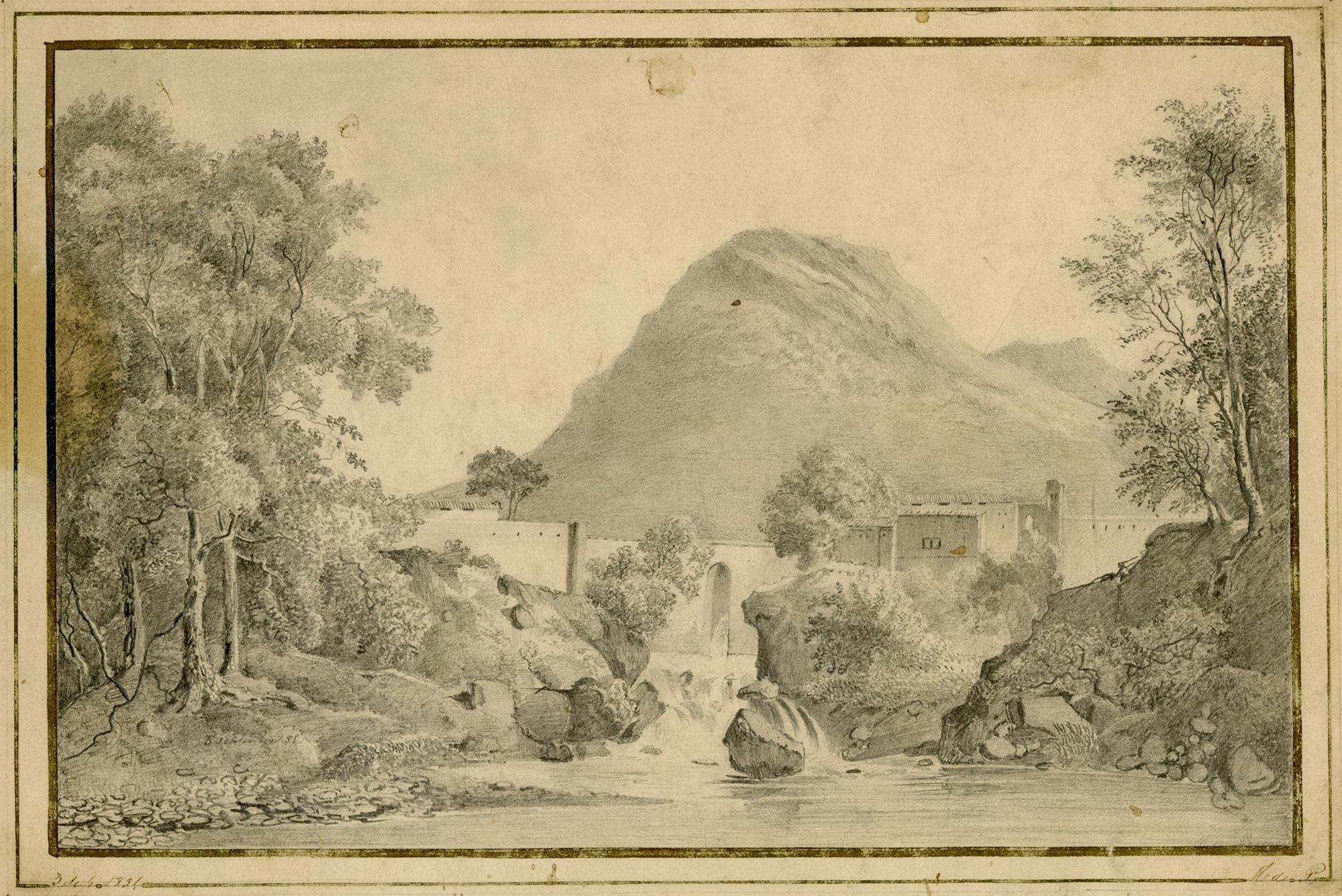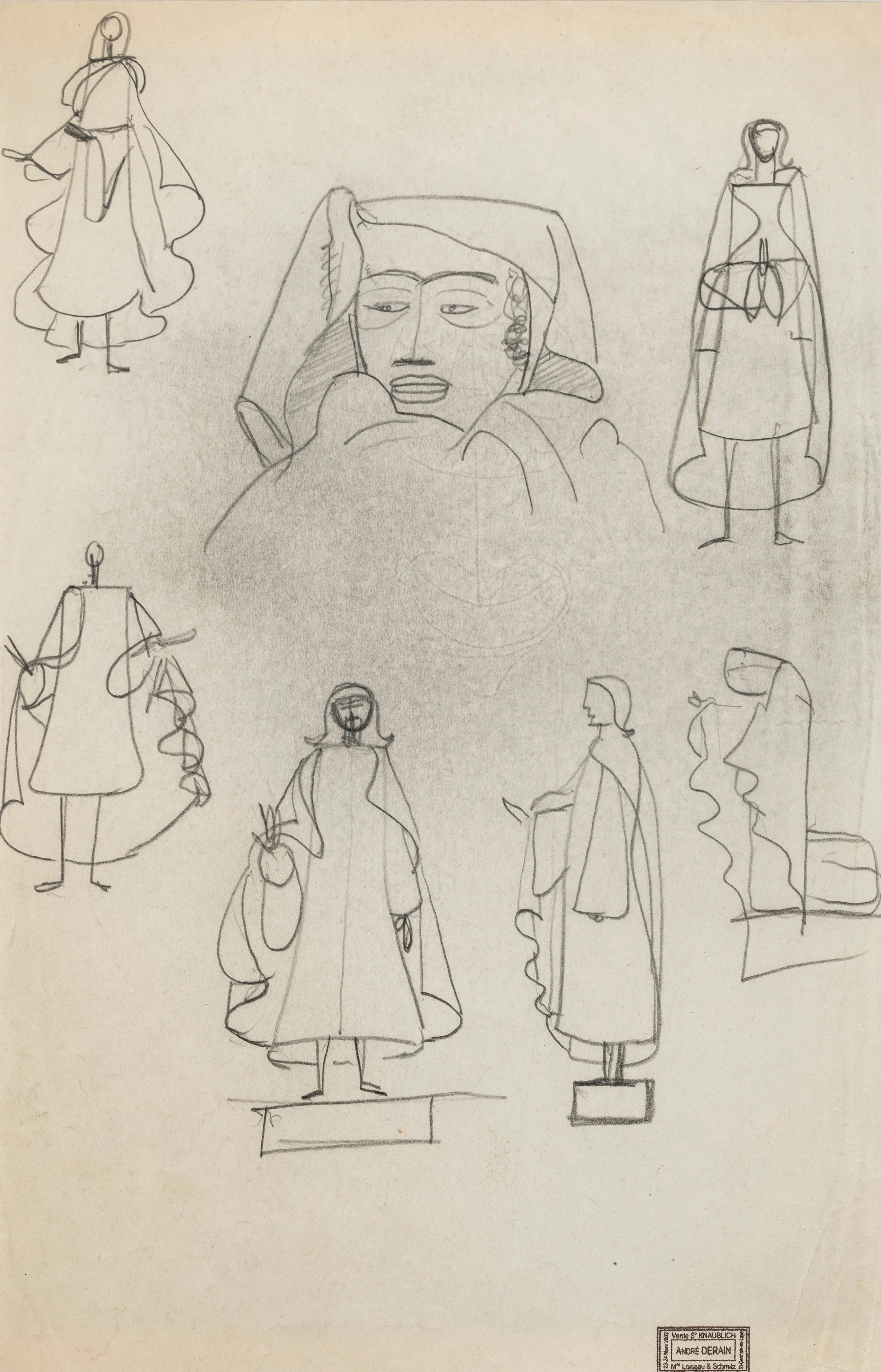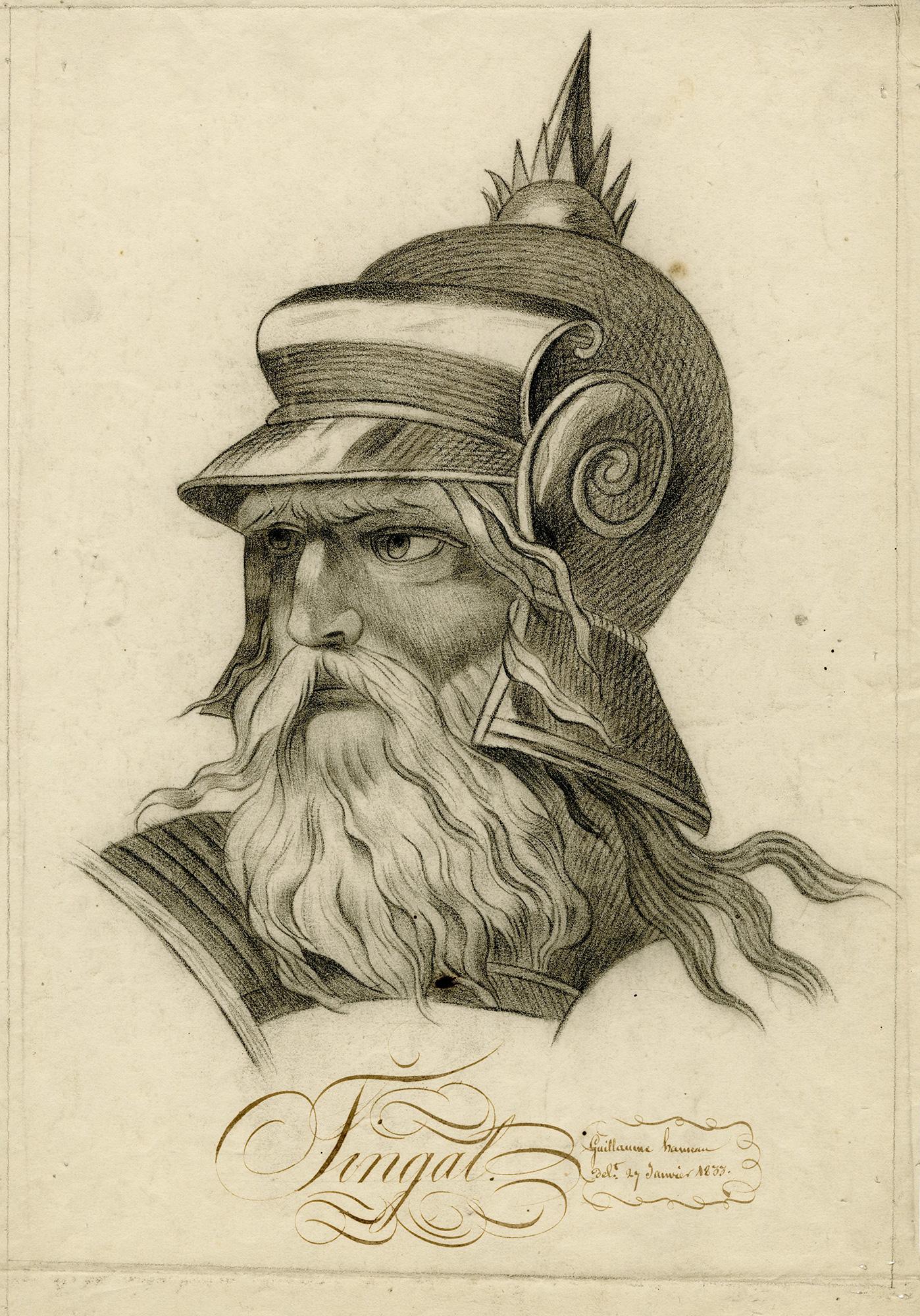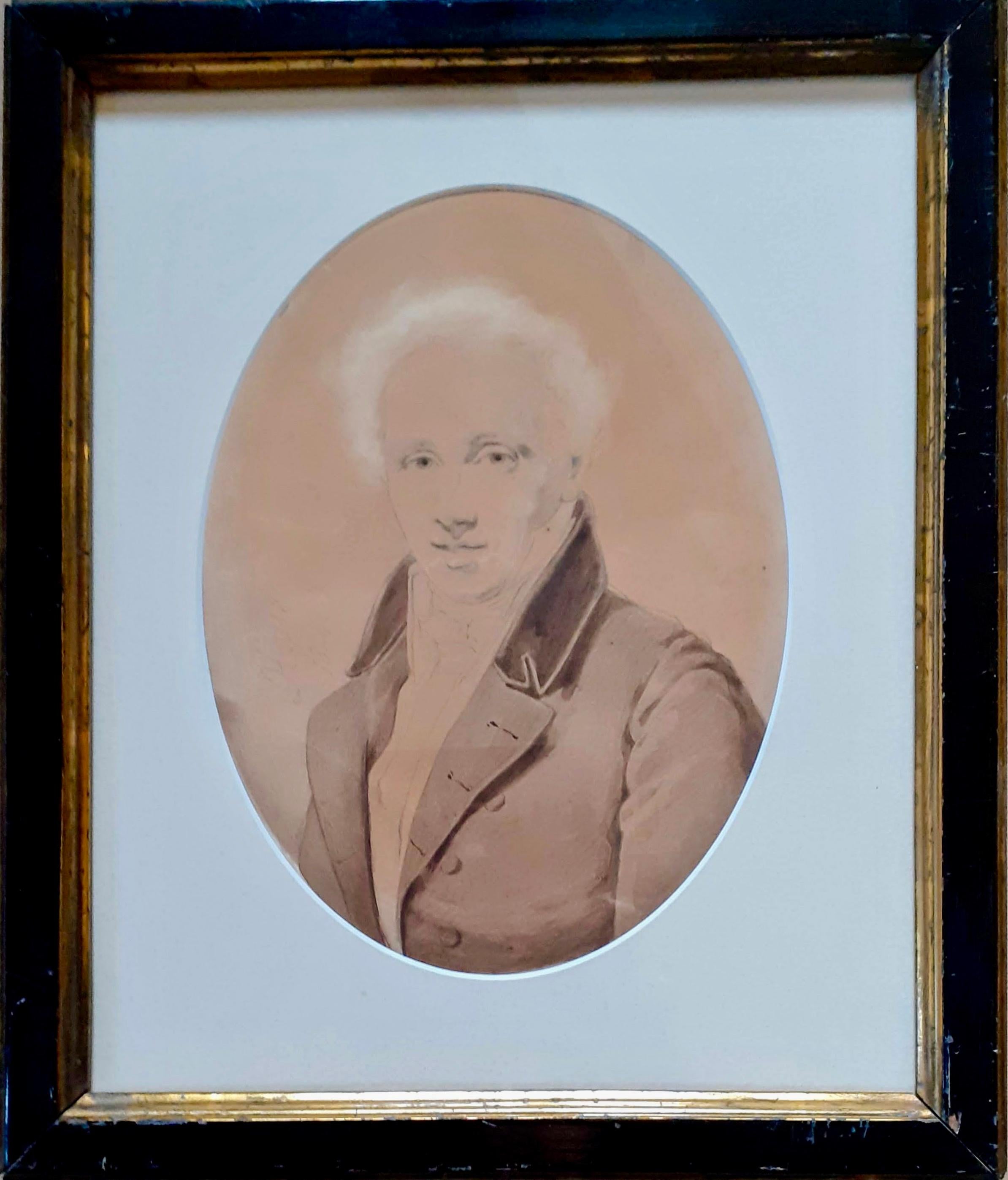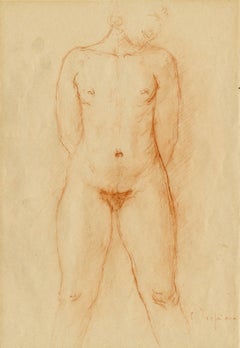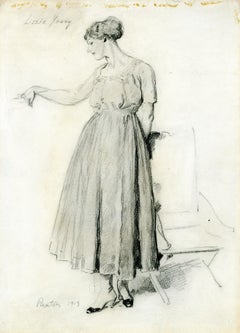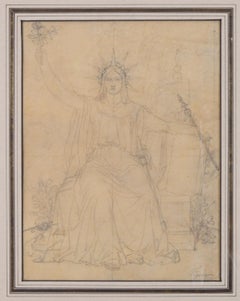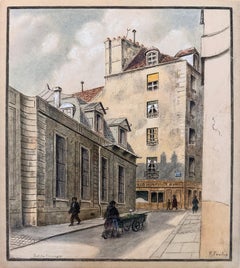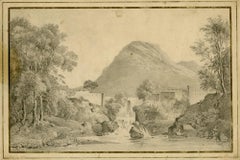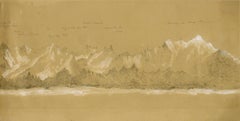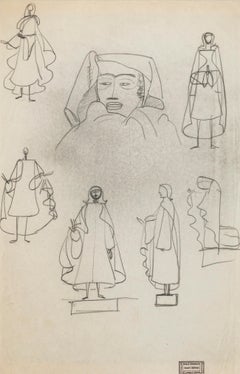Items Similar to Untitled (Standing man with umbrella behind)
Want more images or videos?
Request additional images or videos from the seller
1 of 5
Charles MaurinUntitled (Standing man with umbrella behind)c. 1890
c. 1890
About the Item
Untitled (Standing man with umbrella behind)
Graphite on paper, c. 1890's
Unsigned
Provenance: Estate of the Artist
Lucien Goldschmidt (1912-1992), noted art
dealer and scholar on Maurin
From the artist's sketchbook/record book, with the typeface number "561"
Image size: 7 7/8 x 6 1/4 inches
Condition: Good, tipped to support sheet
Charles Maurin
le puy-en-velay 1856 - grasse 1914
Biography
Having won the art scholarship known as the Prix Crozatier in 1875, Charles Maurin entered the Ecole des Beaux-Arts in Paris, studying with Jules Lefèbvre and Gustave Boulanger, and with Rodolphe Julian at the Académie Julian. He first exhibited at the Salon des Artistes Français in 1882, where he showed a pair of portraits, one of which gained an honourable mention. He continued to exhibit at the Salon des Artistes Français until 1890. He participated in the Salon des Indépendants for the first time in 1887, showing a number of paintings, drawings and engravings that were admired by, among others, Edgar Degas. As an artist, he worked in a variety of styles, the most distinctive being a sort of Symbolism evident in a range of allegorical subjects that he treated.
Maurin had a lifelong interest in the depiction of the female nude, and, like Degas and Mary Cassatt, was fond of portraying women at intimate moments of their daily routine. He also produced a handful of splendid portraits, mainly in the 1880s and 1890s, of friends, patrons and fellow artists including Georges Seurat and Rupert Carabin, as well as drawings and pastels of café, theatre and street scenes. Around 1885 he took up an appointment as a professor at the Académie Julian, where he met Félix Vallotton, who became a close friend. Another good friend was Henri de Toulouse-Lautrec, with whom Maurin shared an exhibition in 1893 at the Galerie Boussod et Valadon in Paris. It was there that, at the urging of Degas, the collector Henry Laurent began to acquire Maurin’s work, eventually becoming his foremost patron and collector.
The 1890s found Maurin enjoying a moderately successful career, with one-man shows with Ambroise Vollard in 1895 and at Edmond Sagot in 1899. He received a commission from the State for a painting of Maternité (Motherhood); completed in 1893 and sent to the museum in his native town of Le Puy, the painting was soon regarded as one of the artist’s finest works. The previous year he took part in the inaugural Salon de la Rose + Croix, where he showed one of his largest and most important paintings; a monumental triptych entitled L’Aurore (Dawn). He also contributed works to the Salons de la Rose + Croix of 1895 and 1897. Maurin painted a series of large decorative panels of Tragedy, Dance and Music for the foyer of the municipal theatre in Le Puy in 1893, and for Sarah Bernhardt designed sets and costumes for Edmond Rostand’s La Princess Lointaine in 1895. He visited Holland, Belgium and England, and sent works to Le Libre Esthétique in Brussels in 1896 and 1897, and the Exhibition of International Art in London in 1898. A man of firm anarchist leanings, Maurin produced illustrations for the radical journal Le Temps nouveau, and published portrait prints of the French anarchists Louise Michel and François Koenigstein, known as Ravachol. In 1895 he was also commissioned to provide illustrations for the art and literary journal La Revue Blanche.
After 1900, however, Maurin’s output declined considerably, partly due to ill health, and the last years of his life were spent in Brittany and Provence, where he died in obscurity in 1914. His work was largely forgotten after his death, although a retrospective exhibition was held at the Galerie Bernheim-Jeune in Paris in 1921, while a monograph on his work by Ulysse Rouchon was published the following year. Although a significant collection of Maurin’s work is today in the collection of the Musée Crozatier in Le Puy-en-Velay, his paintings and drawings remain little represented in museums outside France.
As a draughtsman, Charles Maurin was equally adept in pastel, chalk and pencil, and was highly regarded by critics, collectors and fellow artists; his drawings were, for example, particularly esteemed by Degas, who compared his draughtsmanship to that of his own great hero, Ingres. An innovative artist, he invented a method of using an atomizer to spray pigment onto the surface of the paper to create what he termed ‘peintures au vaporisateur’; large, atmospheric watercolour landscapes of great subtlety and beauty. Maurin is perhaps best known today, however, as a gifted and prolific printmaker, and played an important role in the revival of colour etching and wood engraving in the 1890s. Like his paintings, many of his prints focus on the female nude, or the theme of mothers and children, and account for some of the artist’s most striking and individual works. Maurin also developed a number of new techniques and processes, particularly with regard to printing in colour. Some of his prints were published in editions of ten or less, however, and much of his graphic work remains very rare today.
Although long forgotten or ignored after his death, Charles Maurin’s eclectic oeuvre as a painter, printmaker and draughtsman remains one of the most distinctive of any artist in France in the late 19th century. The French scholar Jacques Foucart, writing in 1979, succinctly described the artist as ‘that curious and libertarian figure, so typical of the effervescent Paris of the Belle Epoque, an engraver of social customs comparable with Louis Legrand, a perfectionist and an inventive technician, a sensitive draughtsman à la Besnard, a friend of Lautrec and Valloton. He created some of the most extravagant humanitarian and ‘socialist’ visions of the fin-de-siècle, which he treated in a flexible and decorative ‘graphisme’ in the manner of Eugène Grasset, or even of De Feure...That an artist of such intriguing qualities – even though, as engraver of nudes, he does at times become rather tiresomely vulgar and commercial – and so representative of a period that was hungry to explore everything (it is often said that all modern art was contained in the years before 1914), has been the subject of neither an exhibition, since that of 1921 at Bernheim’s, nor of a monograph, certainly sets one thinking about the vagaries of Taste and about the nature of the present fashion for the art of 1900.’ In recent years, however, a revival of interest in Maurin’s remarkable body of work culminated in a major monographic exhibition, entitled Charles Maurin, un Symboliste du Réel, at the Musée Crozatier in the artist’s native town of Le Puy-en-Valey in 2006.
Courtesy Stephen Ongpin, London
- Creator:Charles Maurin (1856 - 1914, French)
- Creation Year:c. 1890
- Dimensions:Height: 7.88 in (20.02 cm)Width: 6.25 in (15.88 cm)
- Medium:
- Movement & Style:
- Period:
- Condition:
- Gallery Location:Fairlawn, OH
- Reference Number:Seller: FA122631stDibs: LU14012691742
About the Seller
5.0
Recognized Seller
These prestigious sellers are industry leaders and represent the highest echelon for item quality and design.
Platinum Seller
Premium sellers with a 4.7+ rating and 24-hour response times
Established in 1978
1stDibs seller since 2013
784 sales on 1stDibs
Typical response time: 1 hour
Associations
International Fine Print Dealers Association
- ShippingRetrieving quote...Shipping from: Akron, OH
- Return Policy
Authenticity Guarantee
In the unlikely event there’s an issue with an item’s authenticity, contact us within 1 year for a full refund. DetailsMoney-Back Guarantee
If your item is not as described, is damaged in transit, or does not arrive, contact us within 7 days for a full refund. Details24-Hour Cancellation
You have a 24-hour grace period in which to reconsider your purchase, with no questions asked.Vetted Professional Sellers
Our world-class sellers must adhere to strict standards for service and quality, maintaining the integrity of our listings.Price-Match Guarantee
If you find that a seller listed the same item for a lower price elsewhere, we’ll match it.Trusted Global Delivery
Our best-in-class carrier network provides specialized shipping options worldwide, including custom delivery.More From This Seller
View AllNu (Standing Female Nude)
By Charles Despiau
Located in Fairlawn, OH
Nu (Standing Female Nude)
Red chalk on wove paper, c. 1925
Signed lower right by the artist, see photo
Condition: Excellent
Image/Sheet size: 12 1/8 x 8 5/16 inches
Note:
Despiau ...
Category
1920s French School Nude Drawings and Watercolors
Materials
Chalk
Preliminary Study for the painting Rose and Gold, 1913
By William McGregor Paxton
Located in Fairlawn, OH
Preliminary Study for the painting Rose and Gold, 1913
Graphite on paper, 1913
Signed in pencil lower left (see photo)
Titlted "Lizzy Young" in pencil upper left (see photo)
Lizzy was a modle that Paxton depicts numerous times.
The painting that this drawing is related to, is illustrated in Lee & Krause, William McGregor Paxton, 1869-1941, Plate 32, text on page 132. The painting was formerly in the collection of Victor Spark and the Honorable Paul Buchanan. It is currently in a Texas Collection.
Provenance: Private Collection, Florida
William McGregor Paxton (June 22, 1869 – 1941) was an American painter and instructor who embraced the Boston School paradigm and was a co-founder of The Guild of Boston Artists. He taught briefly while a student at Cowles Art School, where he met his wife Elizabeth Okie Paxton, and at the Museum of Fine Arts School in Boston. Paxton is known for his portraits, including those of two presidents—Grover Cleveland and Calvin Coolidge—and interior scenes with women, including his wife. His works are in many museums in the United States.
Early life
He was born on June 22, 1869, in Baltimore to James and Rose Doherty Paxton. William's father moved the Paxton family and established a catering business in Newton Corner, Massachusetts, in the mid-1870s.
Education
Paxton attended Cowles Art School on a scholarship he attained at the age of 18. He studied with Dennis Miller Bunker...
Category
1910s American Impressionist Figurative Drawings and Watercolors
Materials
Graphite
Preliminary study for Cretan Dancer bronze sculpture
By Boris Lovet-Lorski
Located in Fairlawn, OH
Preliminary study for Cretan Dancer bronze sculpture
Unsigned
Graphite on tracing paper, 1930-1934
Sheet size: 6 7/8 x 7 1/8 inches
Created while the artist was woring in Paris, c. 1930
“The stylizing of the Cretan allegories, used in figures of animals such as horses and bulls, symbolizes the ancient power of the South. These figures reveal a spiritual sensuality as he strives to attain a symbol of the earth and universe endowed with musical values. If man is the center of his idea of life and nature, it is because of the laws that govern the movement of stars and history. The link binding his figures together has, in a sense, a Pythagorean harmony.”
Salvatore Quasimodo, Milan, 1967, quoted from Bush, Boris Lover-Lorski: The Language of Time, page 12.
Regarding the artist:
Boris Lovet-Lorski
Lithuanian/Russian/American
1894-1973
Sculptor, painter, and printmaker, Boris Lovet-Lorski was born in Lithuania in 1894. His mother died when he was age three. His father was affluent and owned real estate. Boris grew up in a privileged environment. He studied architecture and then fine arts at the Imperial Academy of Art in Petrograd, Russia (now Saint Petersburg). Following the revolution in 1917 and its aftermath, Boris immigrated to Boston to live with his brother. In the 1920’s, his stylized, Art Deco inspired sculptures, lithographs, and paintings proved to be popular among the American elite. He exhibited frequently, holding his first solo exhibition in Boston, 1920. In the following years, Boris exhibited in New York at Marie Sterner Gallery, Jacques Seligmann Galleries and Wildenstein and Company. He lived in Paris from 1926 to 1932 where he befriended Joseph Hecht, and was exposed to the works of Pablo Picasso, Ossip Zadkine, Contantin Brancusi and Aristide Maillol. In 1932 he returned to America where he became a citizen later in the decade.
Lovet-Lorski exhibited in the United States, South America, Europe and Asia. He was a member of the Society of Independent Artists (New York), the National Academy of Design (New York), and the Lotos Club (New York), as well as several Parisian salons. His work is in the permanent collections of numerous museums including the Musée Luxembourg, Bibliotèque Nationale, and the Petit Palais in France, the British Museum in London, the Metropolitan Museum in New York, the National Gallery in Washington, the Los Angeles County Museum of Art. (A more extensive list of his works in museums follows) He is considered one of the most successful and recognized sculptors of his generation. His creative influence can be seen in many of his contemporary artists.
He died in Los Angeles in 1973.
Regarding his iconic Art Deco sculptures of Cretan Dancers:
“The stylizing of the Cretan allegories, used in figures of animals such as horses and bulls, symbolizes the ancient power of the South. These figures reveal a spiritual sensuality as he strives to attain a symbol of the earth and universe endowed with musical values. If man is the center of his idea of life and nature, it is because of the laws that govern the movement of stars and history. The link binding his figures together has, in a sense, a Pythagorean harmony.”
Salvatore Quasimodo, Milan, 1967, quoted from Bush, Boris Lover-Lorski: The Language of Time, page 12.
Lovet-Lorski created sculptures of the following major figures
I.J. Paderewski, Prime Minister of Poland
Arturo Toscanini, Italian Conductor
Lilian Gish, Actress
President Franklin D. Roosevelt
Mrs. M. C. Niarchos, wife of Stavros Niarchos
President Abraham Lincoln
James Forrestal, Secretary of the Navy, First Secretary of Defense
Pope Pius XII
Dr. Albert Einstein, theoretical physicist
President Dwight D. Eisenhower
Albert Schweitzer, theologian, organist, writer, humanitarian, philosopher, and physician
General Charles De Gaulle, President of the Fourth and Fifth Republic, France
John Foster Dulles, Secretary of State, 1953-1959
President John F. Kennedy
Works by Lover Lorski are in the following public collections:
Albright-Knox Art Gallery, Buffalo
Art Institute of Chicago
Bibliotheque Nationale, Paris
Brandeis University, Waltham, MA
British Museum, London
Boston University
Brooklyn Museum
California Palace of the Legion of Honor, Sam Francisco...
Category
1930s Art Deco Figurative Drawings and Watercolors
Materials
Graphite
Study for Republic Standing
By Pierre-Roch Vigneron
Located in Fairlawn, OH
Study for “Republic Standing”
Graphite on calque tracking paper, c. 1848
Signed lower right corner: Vigneron
Provenance:
Shepherd Gallery, New York
...
Category
1840s Romantic Figurative Drawings and Watercolors
Materials
Graphite
Head of a Deco Woman (recto) Standing Male Model (verso)
By Paul H. Winchell
Located in Fairlawn, OH
Head of a Deco Woman (recto) Standing Male Model (verso)
Graphite on paper, 1925
Signed with the artist's initials "PW" and dated 1925
Created while the artist was studying at the ...
Category
1920s Art Deco Figurative Drawings and Watercolors
Materials
Graphite
Head of a Deco Woman (recto) Standing Male Model (verso)
By Paul H. Winchell
Located in Fairlawn, OH
Head of a Deco Woman (recto) Standing Male Model (verso)
Graphite on paper, 1925
Signed with the artist's initials "PW" and dated 1925
Created while the artist was studying at the Art Institute of Chicago in 1925.
This is a preliminary drawing to a series of class assignments.
From a sketch book
Image/Sheet size: 7 5/8 x 4 7/8 inches
Condition: Excellent Slight syrface dirt
Provenance: Estate of the Artist
Winchell Heirs
Paul H. Winchell (1903 – 1971) was a printmaker, illustrator, teacher, and gilder according to Crump, 2009 (Minnesota Prints and Printmakers, 1900- 1945, Minnesota Historical Society Press). He was the son of Mrs. Looman Winchell of Shepherd Rd as noted in a 1937 newspaper article (Painsville, O. Telegraph). Winchell grew up in North Perry, Ohio and then studied and worked as an instructor at the Art Institute of Chicago. He studied with Leon Kroll (1884 – 1974), Boris...
Category
1920s Art Deco Figurative Drawings and Watercolors
Materials
Graphite
You May Also Like
Rue de Thorigny, signed F. Feuilloy
Located in Middletown, NY
Graphite and crayon in color with white heightening on cream wove paper, 13 1/2 x 12 1/4 inches (343 x 310 mm) (sheet). In good condition with uniform toning, handling creases, and lightly dog-eared corners.
The building on the left is a hotel particulier in Paris' Marais neighborhood, the Hôtel Salé, which now houses the Musée Picasso.
Category
Late 19th Century French School Landscape Drawings and Watercolors
Materials
Crayon, Handmade Paper, Graphite
Mountain landscape with an aqueduct and dam - FRENCH SCHOOL
Located in Middletown, NY
Pencil on smooth cream wove paper with a window pane drawn in gold ink, 8 3/8 x 11 3/4 inches (213 x 298 mm). Signed illegibly and dated in ink and again in pencil within the lower m...
Category
Mid-19th Century French School Landscape Drawings and Watercolors
Materials
Gold
Chaîne de Aravais (Mountains in the Alps) - French School, drawing, circa 1850
Located in Middletown, NY
A beautiful drawing of the Aravis mountain chain in the Alps, including Mont Blanc, with all of the peaks identified by hand.
Circa 1850
Graphite with white heightening on light card...
Category
Mid-19th Century French School Landscape Drawings and Watercolors
Materials
Cardboard, Color Pencil, Graphite
Male figure and silhouette sketches
By André Derain
Located in PARIS, FR
Double-sided work in good condition, dispersal of the Knaublich succession, Loiseau-Shmitz, 23/03/2002. Tampon "Atelier Derain" at bottom right. Exhibitions:Talismans VI, galerie Her...
Category
1940s French School Figurative Drawings and Watercolors
Materials
Paper, Graphite
Portrait of Fingal / Finn MacCool - A moving portrait of an Irish literary hero
Located in Middletown, NY
Black chalk and graphite on light weight cream wove paper, 16 1/8 x 11 1/4 inches, (410 x 286 mm), the full sheet. Signed, titled, and dated in sepia ink in the lower-center sheet area. With horizontal folds approximately 1-inch from the sheet edge at each of the four sheets. The drawing appears to have been folded at the sheet edges to fit into a frame.
Finn mac Cumail (or mac Umaill), often anglicized Finn McCool or MacCool, is a hero in Irish mythology, as well as in later Scottish and Manx folklore. He is the leader of the Fianna bands of young roving hunter-warriors, as well as being a seer and poet. He is said to have a magic thumb that bestows him with great wisdom. He is often depicted hunting with his hounds Bran and Sceólang, and fighting with his spear and sword. Fionn MacCumhail was transformed into the character "Fingal" in James Macpherson's poem cycle Ossian (1760), which Macpherson claimed was translated out of discovered Ossianic poetry written in the Scottish Gaelic language.
Fionn MacCumhail features heavily in modern Irish literature. Most notably he makes several appearances in James Joyce's Finnegans Wake...
Category
Early 19th Century French School Portrait Drawings and Watercolors
Materials
Handmade Paper, Chalk, Graphite
Portrait of a Gentleman in a Redingote by student od Jean Louis David drawing
Located in Norwich, GB
An exceptional ink, wash and graphite portrait of a gentleman by Henri-Joseph Hesse, dating from circa 1820, the time of the Bourbon restoration in France. It depicts a dashing figur...
Category
Early 19th Century French School Portrait Drawings and Watercolors
Materials
Paper, Ink, Graphite
Recently Viewed
View AllMore Ways To Browse
Man Standing
Dancing Man
Sets Of Watercolor Prints
Umbrella Paintings
Painting Of Umbrellas
Mary Manning
Pair Of Large Drawings
Charles Littler
Dancer Figure Drawing
Figure Dance Drawing
Large Portrait Standing
Antique Rose Drawing
Charles Gaines
Triptych Drawings
Rare Umbrella
Umbrella Man
Man With Umbrella
Charles Belle

